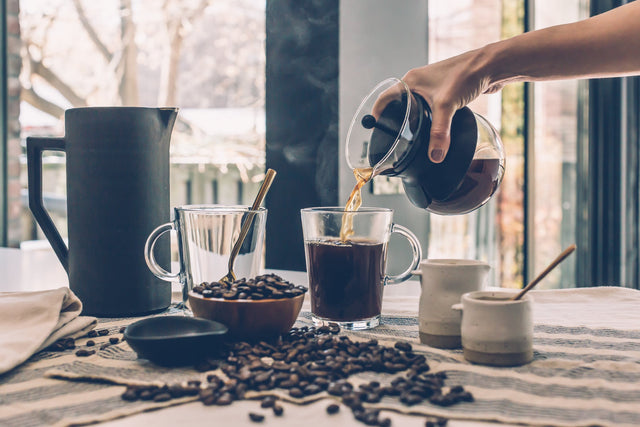Nothing compares to a cup of brewed coffee from freshly roasted beans early in the morning to start your day. From opening a quality coffee bean bag to basking in its aroma, the feeling is one of a kind. But before enjoying the flavors, you will need to grind your coffee beans the right way.
Coffee enthusiasts sure know their way into it, but for starters, there may be plenty of questions. How do you grind the beans? What do I need to use? Is a coffee grinder the only way, or are there any other methods? Don’t worry; we will guide you on grinding coffee beans using effective means to help achieve your ideal coffee grounds.
How to Grind Coffee Beans
Most coffee lovers rely on grinders to deliver high-quality coffee grounds, typically resulting in more consistent brews. While they are not the only way to pulverize beans, coffee mills are undoubtedly more effective and effortless. However, there are alternative methods that you may use, like blenders and hammers, if you don’t have any grinders available.
Using Grinders for Coffee Beans Contribute to More Consistent Grind
Using coffee grinders almost always guarantees a better and more uniform grind, whether coarse or fine. An excellent mill can elevate your everyday coffee experience, letting you control your coffee’s flavor, texture, and aroma. It also ensures that the coffee grounds don’t pile together, maintain the beans’ temperature when grinding, and disperse coffee uniformly.
Among the most critical points that influence the perfect coffee blend is using the appropriate type of grinder. Various kinds of coffee grinders are available, each with different qualities affecting your grind, so understanding them is crucial. Here are some of the more common grinder types:
-
Blade Coffee Grinder Are the Most Affordable
Blade coffee grinder is the most common type, especially for households, as it is available almost everywhere. It is also cheaper than the other varieties and uncomplicated to use- pressing a button is all you need. Blade grinders also allow for effortless cleaning and maintenance, unlike other electric mills.
A blade coffee grinder contains a double-pronged blade at the container’s bottom that spins rapidly and slices everything it hits. The primary issue with it is that it yields unsatisfactory coffee grounds, with inconsistent sizes of small to larger bits. One processing session is often inadequate and results in some partially-chopped beans, which requires you to grind the coffee more.
-
Burr Coffee Grinder for the Best Grind
Many people in the coffee-making industry, and even the simple enthusiasts, consider burr coffee grinders the best there is. They rely on two burrs rotating in different paths steering the beans down a funnel, crushing them into consistent size. Two types of burr coffee grinders are available- flat and conical types- both with pros and cons.
The flat burr grinder may generate heat, altering the coffee’s flavor, but it gives an accurate, fine-grained, and consistent grind. Conversely, conical grinders may not deliver a perfect uniformity, but they are cheaper, simpler to preserve, and generates less heat. Both types generally have multiple settings for adjustments and can last a long time, making them quality purchases.
-
Electric Grinders Are Speedy and Adaptable
If you’re always in a rush, an electric grinder may be perfect for you, as it mills coffee beans quickly. It also provides more refining settings and grounds a higher amount of fresh coffee at the tap of a button. There are over 40 grind modes for high-quality electric coffee grinders, spanning from French press to espresso- whatever you prefer.
But be wary of cheap electric coffee grinders because flexibility and performance should come at a hefty price. Low-end mills utilize low-quality components and materials that fail to create uniform grind sizes and quickly break down. However, even the fanciest electric grinders available can get a bit noisy and is demanding in maintenance.
-
Manual Coffee Grinders Are Cheap and Excellent
A manual grinder, which operates like a pepper mill by crushing beans between dual burrs, is smaller and cheaper. It keeps a tiny amount of coffee beans and involves spinning the handle numerous times to pulverize. It even allows you to modify the grinding size to accommodate whatever variety of home coffee maker you own.
In using a manual coffee grinder, you may be able to obtain a surprisingly precise grind without needing electricity. The only drawback is that creating a little coffee requires a great deal of effort. Coffee beans are naturally tough and immune to crushing; you’ll get some decent morning exercise from manual mills.

Grind Coffee Beans Easily Without Grinders
Yes, enthusiasts and, generally, most people who opt into coffee beans than grounds probably have grinders, but what about starters? What if you are still trying it out to see if you’ll like fresh roasts and join the trend? Or maybe, you have a coffee grinder but woke up to find it broken, not functioning as it always does?
Well, we can help you out with those problems. With various tools in your kitchen and some hard work and determination, we’ll guide you on grinding those beans effectively. Here are some simple ways to grind coffee beans without a grinder:
-
Blenders Give Coffee Beans a Consistent Grind
A blender is probably the most suitable and capable coffee grinder substitute you can use at your home. It may not produce the same consistency as burr mills or blade grinders, but it sure does an excellent job. Some blenders even have a “grinder” setting, making it even easier for you to crush coffee beans!
Similar to a bladed coffee grinder, a blender works by quickly slicing the coffee beans. However, remember to grind in brief, swift intervals instead of incessantly working the blender to prevent heating up the beans. You don’t get much control over your ground size, but for a decently coarse grind, you’ll achieve the desired results.
-
Mortar and Pestle Gets You Back to Basic
Using mortar and pestle to ground things is time-worn and traditional, yet useful if you need to grind coffee beans. It involves a combination of pummeling and rolling movements, which results in getting a uniform grind mix. The downside to using mortar and pestle for grinding is that it can be time-consuming and tedious.
It takes more time to grind with mortar and pestle than blenders and food processors, but it provides more precision. It can produce powdery or coarse grounds, as determined by how long and how tightly you pestle the coffee beans. Be extra cautious not to grind them into un-filterable powder, or you’ll be down making a cup of mud.
-
Hammer or Meat Tenderizer for Crushing
To grind coffee beans quickly, you can use a mallet, hammer, or meat tenderizer, and it isn’t too time-consuming either. The coffee ground should get thinner and better as you continue to break down the beans. It would be best to carefully press the beans since the mallet can hit your hand and damage your countertop.
Place your beans into a ziplock bag, then push the air out before locking the bag to prevent bursting it. Begin grinding on one side of the pack for a more efficient grind and steadily transfer to the other side. Such a technique should generally yield coarse to medium coffee grounds, so don’t expect some espresso out of it.
-
Rolling Pins Grind Coffee Beans More Evenly
A rolling pin lets you ground your coffee beans without grinders, whether it be the wood, marble, or stainless-steel kind. It enables you to grind a little more evenly than hammers while using a more familiar tool in people’s homes. However, to maintain consistency, you should put in some hard work while paying careful attention to the procedure.
Using a rolling pin brings out a more even grind while also creating smoother coffee grounds than any other technique. However, it is a little labor-intensive, but it can provide you the results you like in a rush. This technique will produce a medium-fine to fine grind, suitable for a drip or pour-over brew if done correctly.
-
Food Processor Is an Excellent Alternative
A food processor is among your better choices- close to a blender and a broader variant of a blade grinder. The process it grinds your coffee is just like a blade grinder, but you’ll have minimal control over ground size. You would have similar outcomes to a blender, but you may need more beans because it is typically bigger.
It’s best to utilize a food processor to grind beans for a French press since the results can be coarser. You can also get medium-fine coffee ground if you allow the processor to work on the beans for more minutes. It can also offer a deeper, more robust flavor to your coffee.
-
Hand Mincers Can Also Be Effective
Hand mincers- also referred to as meat grinders- are used to cut most meat and vegetables into thinner pieces. They are initially large and heavy metals, but some latest versions of hand mincers are light plastic. It has a hand crank for control and an internal blade system to sliced up anything you put in it.
You can only process a tiny amount of coffee beans at a time when using a hand mincer. You can filter your grinds and add any big chunks back into the grinder several times if needed. This method may be suitable for you if you aim to produce coarse, medium, and extra-fine ground coffee.
Different Kinds of Grind for Your Coffee Beans
Your coffee grounds are the most critical yet neglected aspect of creating an excellent brew. While fine ground beans can produce quite a bit of flavor, they may not be suitable for making certain brews. Different coffee-making methods and, most of the time, personal preferences require distinct forms of coffee grinds.
Fundamentally, how you grind your coffee beans determines how you extract the taste when pouring water. The beans’ fineness and coarseness influence how rapidly the water will flow through them, deciding the intensity of your coffee. Here is an essential guide to a few key types of grind suitable for specific coffee brews.
-
Extra Coarse Grounds
Extra coarse coffee grinds look similar to ground peppercorns in size- a bit chunkier than the other types. They are perfect for cold brews and cowboy coffee, which involves immersing the grounds in water for an extended period.
-
Coarse Grinds
Coarse grinds resemble sea salts and are generally tinier than extra coarse grounds. They are best for French Press, which requires some excellent balance between coarseness and fineness. This balance is significant in maintaining the coffee’s taste and texture when soaked for about five minutes.
-
Medium Coarse Grinds
Slightly smaller than coarse grinds, medium-coarse coffee grounds are ideal for hand-pour or pour-over brewers, such as Café Solo. This brewing technique allows you to control the water flow and make sure that it pours evenly all over.
-
Medium Grounds
Medium coffee grounds are sandy in texture and are quite popular than most types. It is also what’s in the everyday grocery pre-ground coffees and is perfect for drip coffee.
-
Medium Fine Grinds
Medium-fine grounds are smaller and more consistent than sand, but it is excellent for many pour-over brews. It is also the best type for starters who would like to experiment with their brewing techniques.
-
Fine Grinds
Fine coffee grounds look like silky table salt or powdered sugar. They are the most common grind type- perfect for most espresso machines and Moka pots.
-
Extra Fine Grounds
Extra-fine grounds require a Turkish coffee grinder to achieve their fineness and consistency, which resembles flour. It gives a more robust taste that is perfect for Turkish coffee.

Explore Different Ways to Grind Coffee Beans and Know Your Taste
Grinding your coffee beans the appropriate way is essential to brewing the perfect cup of coffee. Freshly ground coffee produces some of the best flavors and aroma, especially when paired with the proper brewing technique. It may require some hard work and patience, but grinding is worth all of the effort.
Aside from the labor, the tool necessary to grind coffee beans perfectly may discourage most beginners, but they’re investments. And if you don’t have enough yet to buy grinders, there are alternatives for you to use. You can start with the familiar household instruments we mentioned here while deciding the best grounds and grinder for you.
And whatever grind and tool you choose, it is always best to practice. Get consistent. The beginning is challenging, but after a while, you’ll get the perfect technique- and in turn, the best coffee!More stories
What Is Smoked Coffee?



